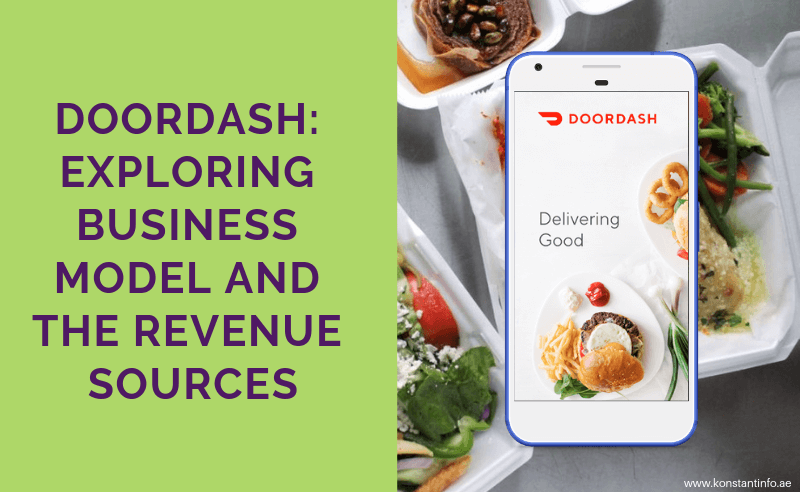
DoorDash is a US-based crowdsourced delivery firm with services available in all 50 states. It is primarily a food delivery service that bridges the gap between the customers and the restaurants. Till date, DoorDash has raised a total of $1.4B in funding over 8 rounds. Their latest funding was raised on Feb 21, 2019, from a Series F round, at a valuation of $7.1 billion.
So, what makes DoorDash stand out? Let’s try to understand the business model of DoorDash.
Insights into the DoorDash Business Model
To stand out, a business model should be such that it offers a win-win deal to all the stakeholders involved, and DoorDash has been making a continuous effort to achieve this.
Some of the distinctive features of this service include:
- Its fleet of drivers called “Dashers” saving restaurants from the delivery hassles
- Offering dashers an opportunity to earn over $600 per annum
- Charging a small food delivery fee from $5 to $8 for the users
- Charging a nominal 20% commission fee from the merchants
Considering the above, we can say that the food delivery business model of DoorDash revolves around three segments- customers, merchants, and the delivery guys; and DoorDash has been sensitive to the needs of all.
Let’s check out the value proposition offered to each segment individually.
Customers
- An efficient food service with better pricing and enhanced efficiency.
- Easy ‘click and choose’ options with a variety of food items to choose from
- 24*7 customer service
Restaurants
- No delivery hassles at all
- Wider customer reach, without the need for any big scale advertising
Drivers
- A good source of full or part-time employment
- An opportunity for potential extra earning via tips
With these value propositions in place, DoorDash has been making its delivery process a smooth ride. Let’s try to get into the details of how exactly DoorDash works?
DoorDash Business Model
DoorDash revenue model is a simple 4-Step model involving an app to let anyone order food from their favorite restaurant and get it delivered at their doorsteps. The app is available for both Android as well as iOS platforms. Additionally, DoorDash also operates via its website.
The process goes like this:
- Downloading the app and placing an order: Customers can choose their favorite food from their favorite restaurant and place an order. Features like search, nearby restaurants and categories make it easy for the customers to choose. Once the order is entered and the customer checks out, the app will confirm the delivery address and will inform the customer about the time it will take for the ordered food to arrive.
- Payment and Potential Delivery Earnings: The payment is made when the order is placed. On the delivery side, Dashers have a driver app which shows the minimum amount they will earn on an order with the potential for extra earnings via the tips. Dasher checks the orders placed on the app and claims an order of his choice for pickup and delivery.
- Tracking the Order: The packaged food is then picked up from the restaurant by the Dasher who then sets out for the delivery, and the customers can track this entire process. This provides customers an estimation of the expected delivery time.
- Order Delivery: The business operations end when Dashers finally deliver the ordered food. In case of inability to contact the customer, Dashers are expected to get in touch with the business administrator or DoorDash customer support for further instructions.
Now, as we understand how the business operates, let’s try to figure out the revenue streams that make it a viable business model. So, how does Doordash make money?
DoorDash Revenue Sources
Let’s begin by taking a look into the cost structure. Broadly, the costs involve food delivery app development cost and maintenance, sales costs, and Dasher’s salary and retention costs.
To cover up these expenses and earn profits, DoorDash depends on the following revenue sources:
- Commission: DoorDash usually gets a 20% commission from the restaurant chosen by the customer. DoorDash gets this percentage for every order a customer places.
- Advertisement: DoorDash charges the restaurants to place them in the top list for a limited period.
- Delivery fee: The fee is charged based on the distance between pickup and delivery points, and usually ranges from $5 to $8.
These are the major revenue sources for DoorDash that has helped DoorDash grow and expand. However, to be prepared for the future, DoorDash needs to do more.
What the Future Holds
Despite its growth, DoorDash trails behind its rivals in terms of the captured market share. As per Edison Trends, DoorDash controls only 18% of the U.S. food delivery space while Grubhub controls 34% and UberEats controls 28% of the market.
Going forward, DoorDash needs to utilize a significant part of its current funding in automation to make its processes agile and competitive. Given the wide geographic footprint of the service, automation can also offer huge savings to DoorDash. DoorDash has already initiated the process and has tested delivery robots in San Francisco in partnership with Marble, and should continue the efforts.
On the other front, DoorDash is planning to enhance its mobile app performance with more detailed restaurant information. It is also adding more and more restaurants broadening the coverage area and has come up with a rating feature for the customers to rate the entire order based on the delivery service and the food quality.
Overall, at the moment, DoorDash needs to focus on its food delivery services to make them highly efficient and competitive. In the long run, it can focus on its diversification plans too.
If you’re planning for a restaurant app development or looking for on-demand app solutions, get an estimate for your project now.
Conclusion
To sum up, DoorDash is faring well in the food delivery market. The process is simple- customers place an order, make the payment, track the order and finally receive the order. Commission fee, advertisement and the delivery fee make up the revenue sources to meet the business expenses. On the surface, things look fine, however, to sustain and grow in the current competitive market, DoorDash needs to act fast and leverage the latest technology to its advantage.
-
 Top 10 Dating Apps in Dubai and the Rise of Dating Culture
Top 10 Dating Apps in Dubai and the Rise of Dating Culture -
 Top Food Delivery Apps in Dubai for 2024
Top Food Delivery Apps in Dubai for 2024
Konstantinfo
Dedicated to keep you updated in the rapidly evolving domain of technologies, entrepreneurship, and their collective impact on the local business ecosystem with our empowering organizational ideas, board announcements, key information and insightful resources that are valuable to you as an aspiring business and an avid audience.
